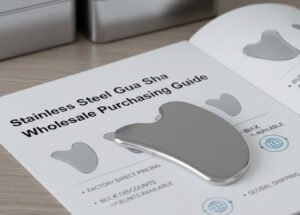
Gua Sha, a traditional Chinese medicine therapy originating from Traditional Chinese Medicine, has become a global skincare and wellness craze in recent years. Celebrities, bloggers, and wellness enthusiasts alike have adopted it as part of their daily regimen. However, many still have questions about it: Does it really work? Can it be performed at home? Will it cause bruising?
To help you better understand Gua Sha, we’ve compiled 10 of the most frequently asked questions and provided concise and practical answers.
- 1. What is Gua Sha?
- 2. Is it Safe to Perform Gua Sha at Home?
- 3. What are the Main Gua Sha Benefits?
- 4. Can Guasha Really “Slim Down the Face and Lift It Up”?
- 5. How Often Should I Perform Gua Sha?
- 6. Can Gua Sha Relieve Headaches or Neck and Shoulder Pain?
- 7. What kind of Oil Should be Used As A Medium for Guasha?
- 8. Does Guasha Leave Bruises?
- 9. Can Gua Sha be Used with A Jade Roller?
- 10. Who is not Suitable for Gua Sha?
1. What is Gua Sha?

Gua Sha is an ancient medical practice originating in China. In ancient times, when resources were scarce and medical technology was backward, people used smooth, hard objects to scrape the skin’s surface for therapeutic purposes. This is a derivative of the early Qi and Blood theory in Traditional Chinese Medicine. Traditional Chinese Medicine is based on Qi and Blood. There’s an old saying: “If Qi and Blood flow smoothly, there will be pain; if Qi and Blood flow smoothly, there will be no pain.” This means that when Qi and Blood flow smoothly, the whole body feels relaxed, without muscle or joint pain.
Traditional Chinese Medicine believes that Gua Sha can activate blood circulation, remove blood stasis, and unclog meridians, thereby alleviating pain or symptoms in specific areas, such as muscle soreness and headaches. Modern research has shown that it can indeed promote blood circulation, relieve muscle tension, and accelerate lymphatic detoxification, thereby improving physical health to a certain extent.
2. Is it Safe to Perform Gua Sha at Home?

Gua Sha is safe if you use the correct technique and understand your body’s conditions. While not 100% safe, clinical research and its application suggest it is a relatively safe method for home use. Just be mindful of the following points:
- Understand your health conditions, such as whether you have cardiovascular disease, are pregnant, or have sensitive skin. Gua Sha is generally not recommended for these individuals.
- Use a lubricant when performing Gua Sha.
- Avoid open wounds, acne, and other areas to prevent secondary injury.
- Use appropriate force, adjusting the intensity based on individual needs and the specific area of the area.
- Avoid the throat, spine, and other bony prominences to avoid injury.
With proper technique and the correct and safe tools, Gua Sha at home is a very safe practice.
3. What are the Main Gua Sha Benefits?

Gua Sha has many benefits, primarily focusing on two key areas: beauty and health. While facial beauty has become a trend in recent years, its health and wellness benefits are traditionally considered:
Facial Beauty
- Improves facial Qi and blood circulation, brightening the complexion.
- Reduces facial edema, achieving a certain degree of facial slimming.
- Lifts facial skin, creating a firmer complexion.
- Relieves symptoms such as dark circles and eye bags.
Traditional Therapy
- Relieves muscle tension, often used to treat stiff shoulders and neck.
- Improves internal circulation and lymphatic drainage, helping the body metabolize excess water and toxins.
- Promotes recovery from sports injuries.
- Relieves headaches, dizziness, and other symptoms caused by sleep deprivation or Qi and blood stasis.
4. Can Guasha Really “Slim Down the Face and Lift It Up”?
Based on theoretical foundations and case studies, Gua Sha may not have a definitive effect on “face slimming and lifting.” Facial skin and muscle laxity is typically caused by cellular aging, a process that is generally irreversible and can only be slowed down by other methods (usually medication). Clearly, the physical effects of Gua Sha cannot slow or even reverse cellular aging.
Many people report experiencing a noticeable thinner and firmer face after Gua Sha. This may be due to the following factors:
- Psychological effects. This may be due to the user’s expectation of facial improvement during Gua Sha, which can lead to a subtle perception of facial slimming and firming.
- Short-term physical effects. The repeated movements of Gua Sha can cause certain changes in the facial skin and muscles over a short period of time, resulting in a thinner appearance. However, these effects are short-lived, typically returning to normal within a few minutes and not long-term.
- Excess water is removed from the face. Gua Sha can help with lymphatic drainage and detoxification. By removing excess fluid from the face through Gua Sha, it can help to slim the face. Therefore, if a person does not have facial edema, the effect of Gua Sha on slimming the face is not obvious.
5. How Often Should I Perform Gua Sha?
The frequency of Gua Sha depends on the purpose of use and individual differences. Gua Sha can be divided into two types: facial beauty and health therapy. Generally speaking, facial beauty Gua Sha can be used more frequently than health therapy. This is due to the difference in frequency of use between the two.
Facial beauty requires gentle pressure, while health therapy requires a relatively firm pressure. Therefore, the recommended frequency of use for the two differs significantly. For facial beauty Gua Sha, it is recommended to maintain a frequency of once daily (in the evening or early morning). For health therapy, it is recommended to wait at least three days, until symptoms such as erythema caused by the Gua Sha subside.
In addition, individual physical differences will also affect the actual frequency of Gua Sha use, so it is necessary to adjust it according to your individual situation.
6. Can Gua Sha Relieve Headaches or Neck and Shoulder Pain?
It depends on the cause of the headaches and neck and shoulder pain. For headaches and neck and shoulder pain caused by muscle stiffness, lack of sleep, etc., gua sha can effectively relieve them.
It’s important to note that if gua sha doesn’t relieve these symptoms, seek professional help.
7. What kind of Oil Should be Used As A Medium for Guasha?
What type of gua sha oil should you choose? This depends on your skin type and preferences; there’s no absolute standard. The primary purpose of gua sha oil is to reduce friction, thereby minimizing the damage caused by gua sha. Its secondary function is to improve skin through its individual ingredients. Here are some recommendations:
- Jojoba oil → Refreshing and pore-friendly;
- Rosehip oil → Rich in vitamins and repairs skin;
- Squalane → Suitable for sensitive and oily skin;
- Serum → Can also be used with skincare products like hyaluronic acid and vitamin C serums.
It’s important to avoid using heavy mineral oils or coconut oils, as they can clog pores, especially for those with oily skin.
8. Does Guasha Leave Bruises?
Usually not. For facial Gua Sha, the gentle pressure applied is minimally irritating and does not harm the skin. However, for body Gua Sha, symptoms such as subcutaneous bruising and redness may occur. However, unless there are underlying health issues, these symptoms typically subside within 2-5 days.
We recommend that people with scar-prone constitutions avoid Gua Sha or use it only under the advice and supervision of a professional.。
9. Can Gua Sha be Used with A Jade Roller?
Yes, and using Gua Sha and a jade roller together is a popular combination. Their different benefits complement each other, resulting in enhanced results:
- Jade roller: Cools and soothes, perfect for morning swelling reduction;
- Gua Sha board: Deep massage, perfect for evening relaxation and lifting.
10. Who is not Suitable for Gua Sha?
Gua Sha can affect the body’s Qi and blood circulation, and can also have short-term adverse effects on the skin and subcutaneous capillaries. Therefore, it is not recommended for the following groups:
- Pregnant women. While facial Gua Sha is acceptable, body Gua Sha should be avoided or performed under the guidance of a professional doctor.
- People with bleeding disorders or those taking anticoagulants. Gua Sha can rupture subcutaneous capillaries, and for those with impaired blood coagulation, serious side effects may occur.
- People with open wounds or acne should avoid Gua Sha in these areas.
- People who have recently undergone cosmetic surgery should avoid Gua Sha in the same areas where the procedure was performed.
The above 10 topics are some of the most popular topics about Gua Sha. You can find the answers in our answers. The answers may contain some omissions. If you have additional comments, please let us know.






